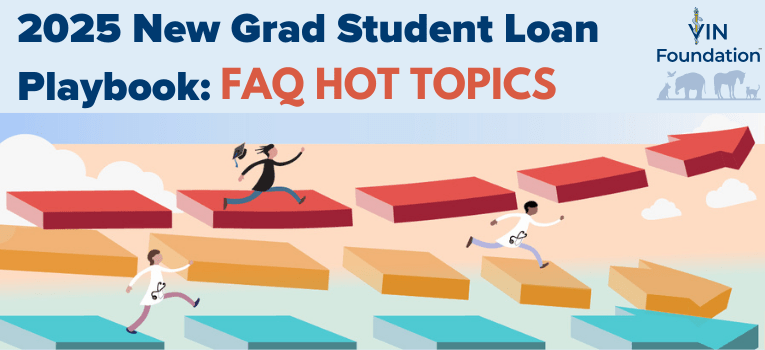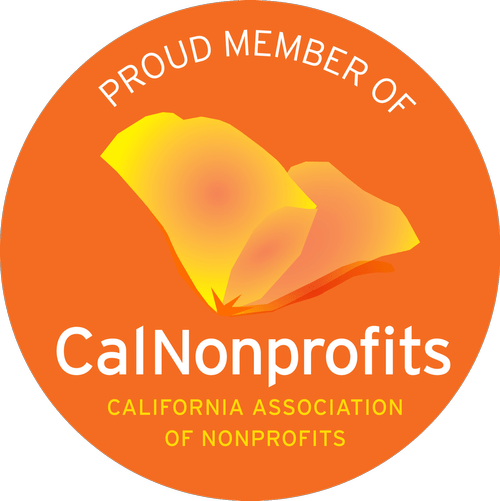What is the "New Grad Student Loan Playbook" webinar about?
The “New Grad Student Loan Playbook” is an annual webinar by VIN and VIN Foundation aimed at providing information and guidance to graduating veterinarians regarding their student loans and repayment options.
With the rapidly changing student loan landscape, each graduating class faces new and different challenges. Some of the most consequential mistakes happen during the initial phase of student loan repayment.
The most recent webinar, held on May 7th, 2025, covered topics such as whether to file a 2024 tax return, the implications of consolidating loans, choosing the right repayment plan, and whether using a signing bonus to pay down loans during the grace period is a good idea.
During the recent 2025 New Grad Student Loan Playbook webinar, there were many questions. Below are the questions and answers focused on Student Loan Grace Periods:
Q: What are the grace periods for federal student loans?
A: Federal Direct Unsubsidized Loans and Direct Grad PLUS loans both have a 6-month post-graduation grace period. Technically, the Direct Unsubsidized Loan has a grace period and the Direct Grad PLUS loan has a 6 month post-graduation deferment.
Direct Unsubsidized Loans should enter their post-graduation grace period status shortly within the first two weeks after graduation. Contact your financial aid office if this isn’t reflected in your studentaid.gov dashboard. Your Direct Grad PLUS loans will likely show “deferment” or “STD 10 Year” during their post-graduation 6 month deferment period.
Both require no payments during this post-graduation grace or deferment period, but interest continues to accrue. While you can make voluntary payments during your grace period, you cannot earn forgiveness credit during your grace period.
Health Professions Student Loans (HPSL) and Loans for Disadvantaged Students (LDS) have a 12-month grace period. It can take 30-60 days for HPSL and LDS to officially enter their grace period after graduation. No interest accrues during the grace period for these loans. HPSL and LDS can also be deferred during advanced training (internships and/or residency training with no interest accrual). To make HPSL or LDS eligible for IDR or PSLF, you must add them to a federal Direct Consolidation Loan. If you do not consolidate HPSL or LDS, they will enter a fixed 10-year repayment plan after the grace period ends. There is no other repayment option available for HPSL or LDS.
Loans have only one grace period. If you have older loans from before veterinary school that have already used up their grace period or have previously been in repayment, they will re-enter repayment shortly after graduation.
Q: Why is it not a good idea to make payments during the grace period? Since the unsubsidized federal loans continue to accrue interest during the grace period, is there any reason not to start repayment as soon as we graduate?
A: The short answer: you have better things to do with your limited post-graduation funds than using them to pay your student loans.
The long answer: Payments made to student loans during the grace period first go towards any unpaid interest. Once the unpaid interest for a particular loan is paid off, the remaining amounts are applied to the principal. Payments made during the grace period do not count towards income-driven forgiveness or Public Service Loan Forgiveness.
If you are not applying for a Direct Consolidation Loan to end your grace period early, then focus your financial efforts first on your post-graduation budget. Use your 6-month student loan grace period to jump-start your overall financial wellness strategy:
- Build a dedicated emergency fund equal to 3-6 months of your post-graduation expenses
- Put any signing bonus into a dedicated savings account until any conditions are met (e.g., don’t spend your bonus money if you may be required to pay some or all of it back if you don’t remain with your employer for a certain period of time).
- Pay down less flexible debt: credit card balance, private student loans, other debt
- Start contributing to tax-advantaged savings accounts:
- Employer 401k/403b/SEP IRAs
- Traditional or Roth IRA
- Health Savings Account
- Flexible Spending Account
Q: What if you already had student loans from undergrad or before veterinary school that entered repayment before? You would have to start paying on them 30 days after graduation, or what are the other options?
A: You only get one grace period for each loan. If you have loans from before veterinary school that have already used their grace period and have been in repayment previously, then those loans will re-enter repayment shortly after graduation. Make sure all of your contact information is correct with studentaid.gov and your loan servicer(s) so you don’t miss any payment notifications. Consider applying for an income-driven repayment plan for those loans that re-enter repayment shortly after graduation. If you have a recent tax return available, there is a very good chance your payment using an income-driven plan will be very low or zero on those loans.
You can request a forbearance for your older loans until your veterinary school loans enter repayment. However, it’s up to your loan servicer to grant you that request.
If you are consolidating your loans, you can include the older loans in your consolidation. However, you will need to request a forbearance for those older loans until the consolidation is processed. Caution: Consolidating loans with forgiveness progress will reset that progress.
Q: Why not consolidate at the end of the grace period?
A: Nothing prevents you from consolidating your loans after the grace period ends. However, consolidating after your grace period is less beneficial than consolidating earlier, before your grace period ends.
Interest continues to accrue during your grace period for Direct Unsubsidized and Direct Grad PLUS loans. When you consolidate, the unpaid interest that has accumulated will get capitalized (added to your principal balance). The longer you wait to consolidate, the more interest will capitalize. The higher your principal balance, the more interest you will pay during repayment.
Consolidation also takes 30-60 days to complete. If you wait until your grace period ends, that will add another 2 months of time that is not forgiveness-eligible.
If a Direct Consolidation will help you, submit your application as early as your loans allow (as soon as they enter their grace period after graduation). Doing so will capitalize the least amount of interest possible and allow you to start earning forgiveness credit as early as possible on the maximum balance eligible for forgiveness (IDR or PSLF).
Have more questions? Post a comment below or email [email protected].

Dr. Tony Bartels graduated in 2012 from the Colorado State University combined MBA/DVM program and is an employee of the Veterinary Information Network (VIN) and a VIN Foundation Board member. He and his wife have more than $400,000 in veterinary-school debt that they manage using federal income-driven repayment plans. By necessity (and now obsession), his professional activities include researching and speaking on veterinary-student debt, providing guidance to colleagues on loan-repayment strategies and contributing to VIN Foundation initiatives.



2 thoughts on “2025 New Grad Student Loan Playbook: Live Session FAQ Hot Topics – Student Loan Grace Periods”
Hello,
I am not sure where else to post this so I apologize if it is not the right place to do so. I am an incoming first year that committed to the University of Edinburgh’s GEP program (US student). I know that they have a lower unsubsidized loan limit, and the rest is funded through GradPLUS loans. With the proposed cuts in the reconciliation bill, do you know if they have considered these international schools at all? I know there is supposedly a 3 year grace period, but would that still apply to these schools? I have found no clarity, so I was hoping someone with a better understanding could help me, thank you!
Hi Teodora,
Thanks for your post!
I would encourage you to review the post we have regarding the legislation that passes earlier this month: https://vinfoundation.org/changes-federal-student-loans-come-into-focus/
There is a transition phase built into the law. So students who are starting programs this fall or returning to programs will still borrow under the existing rules as long as you have 3 years or less to complete your program as of June 30, 2026.
You will, however, have access to only the new Repayment Assistance Program (RAP) and a standard repayment plan if you receive a loan after July 1, 2026. If you’re starting a program this year, then you will likely receive a loan after July 1, 2026. We cover those details in the post I mentioned.
Good luck and please feel free to post in the VIN Student Debt Message Board area with additional questions about borrowing and repayment once you start school 🙂